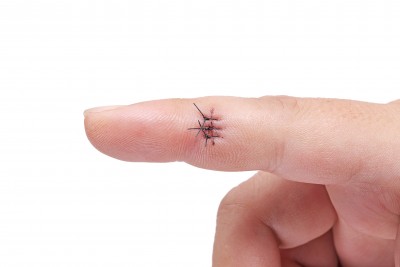Scaring is a natural part of healing: The body is set up to repair damage as quickly as possible to reduce the chance of infection and further injury at the expense of aesthetics and, in severe cases, function. To accomplish this, the wound is covered with a layer of fibrous tissue that has a cross-linked structure as opposed to the random structure of undamaged skin.
Physiologically, these repairs can itch or restrict movement. Psychologically, scarring can cause major problems, whether it reminds the sufferer of a tragic event or causes looks from passers-by. In turn, this can lead to post-traumatic stress, self-esteem issues and depression.
Types of Scarring
Scars can be categorized by how they look and by how they are created. Widespread scars involve stretching, and include stretch marks from pregnancy and weight gain as well as long-term repair from surgical incisions. Deeper scars can be contractile or expansive, leaving a dent or bump on the skin.
Treatment of these scars depends as much on the mechanism for scaring as it does the end result. There are three ways the scar can be formed:
Hypertrophic Scars – This is the result of an excess of tissue over the area of the injury. Redness and inflammation is common around this type of scaring.
Keloid Scars – After healing is complete, the tissue growth process may continue, expanding past the area of the original injury. This type of scar can become quite large, particularly if the original injury was on an earlobe. The size of these scars are some of the most disfiguring and most likely to impede movement.
Contracture Scars – This is the opposite of a hypertrophic scar: The injured area is replaced with less tissue, making the skin tight. This is usually the result of repair from burn injuries. In some cases, the tightness is so severe that it restricts movement, particularly if the scar is over a joint.
How is scaring treated?
Chemical peels, high power lasers and dermabrasion remove tissue to stimulate regrowth.
Low power lasers cause rapid heating and cooling, smoothing out the skin’s surface without damaging it.
Steroids injected into the site of the injury can gradually thin the scar tissue, reducing its appearance. Since the drugs don’t enter the blood stream, side effects are minimal.
Fillers like collagen can be used to expand contracted scars, pushing the tissue outward and giving it a support structure.
If it looks like a wound repair will result in expansive scars, pressure dressings may be used for direct tissue growth.
In severe cases, surgical procedures may be used to cut away scar tissue. The success rate for keloid scar removal is only about 50%, so most treatments involve a combine surgery with less invasive methods to keep tissue growth at bay.
Will insurance cover scar repair?
Insurance policies should cover scars that impede movement and are the result of a medical condition. Cosmetic scar repair or repair of scars caused by cosmetic surgery must be covered by the patient.
John is a regular contributor to several health blogs. Currently, his biggest project is connected with treatment of cellulitis skin medical condition website.

